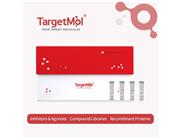| Name | Capsiate |
| Description | Capsiate is an orally active TRPV1 agonist, a non-irritating capsaicin analog that acts as an antiallergic agent with anti-inflammatory, antioxidant, hypoglycemic, and inhibitory angiogenic activity. |
| In vitro | Capsiate elicits current responses in HEK293 cells expressing TRPV1[3]. Additionally, Capsiate (5 to 25 µM) inhibits Src and VEGF-induced proliferation and tube formation in human umbilical vein endothelial cells (HUVECs)[1]. |
| In vivo | Capsiate (0.03~0.54 mM; s.c.) induces nociceptive responses in mice.[3]
Topical application of Capsiate reduces antigen-induced increases in ear thickness in a mouse model of passive cutaneous anaphylaxis and decreases epidermal thickness and eosinophil and mast cell infiltration in a mouse model of atopic dermatitis.[3]
Capsiate (10 mg/kg) decreases body weight gain and perirenal fat weight, as well as increases oxygen consumption, fat oxidation, and carbohydrate oxidation, in a mouse model of ad libitum feeding-induced weight gain.[4] |
| Storage | store at low temperature | Powder: -20°C for 3 years | In solvent: -80°C for 1 year | Shipping with blue ice. |
| Solubility Information | DMSO : 90.0 mg/mL (293.7 mM), Sonication is recommended.
|
| Keywords | Capsiate |
| Inhibitors Related | Fingolimod hydrochloride | Butylated hydroxytoluene | Hydroquinone diacetate | Fulvic Acid | Methyl 3,4-dihydroxybenzoate | Butylhydroxyanisole | Probenecid | Oxothiazolidinecarboxylic acid | Sulbutiamine | (-)-Fenchone | 2-aminobenzo[d]thiazol-6-ol | Trolox |
| Related Compound Libraries | Bioactive Compound Library | Traditional Chinese Medicine Monomer Library | Membrane Protein-targeted Compound Library | Rare Natural Product Library | Selected Plant-Sourced Compound Library | Drug Repurposing Compound Library | Natural Product Library for HTS | Anti-Aging Compound Library | Bioactive Compounds Library Max | Ion Channel Targeted Library |

 United States
United States



